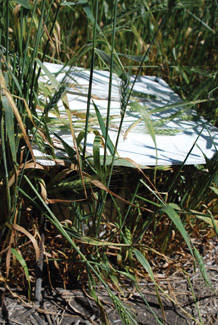
Features
Agronomy
Identity Preserved
Barley management influences wild oats and disease pressure
Including canola in rotation, along with increased seeding rates of a competitive barley variety help to increase yield.
November 29, 2007 By Top Crop Manager
In central Alberta, and other areas of the prairies, where continuous barley
for silage and seed is grown, the limited agro-ecosystem favours pest outbreaks
for both weeds and disease. To better understand how this limited rotation affects
crop production, George Clayton, a research scientist at Agriculture and Agri-Food
Canada at Lacombe, along with colleagues from AAFC Lacombe, Beaverlodge and
Brandon, set out to find how various barley management practices would impact
on wild oats and disease pressure, and ultimately yield.
 |
| Tall barley at high seeding rates allows lower herbicide rates, and is better able to compete with weeds in a canola rotation. |
"We need to integrate research studies, or we can miss interactive effects,"
says Clayton, who worked on the research project with funding from the Alberta
Barley Producers Commission. He says that short-term experiments can lead to
low input management recommendations that are profitable in small segments.
However, it is doubtful if such practices would continue to be profitable due
to carryover effects of uncontrolled weeds and diseases.
In Clayton's study, field experiments were conducted at Beaverlodge, Fort Vermilion
and Lacombe, Alberta, and Brandon, Manitoba in 2001, 2002 and 2003. The objective
was to determine the cumulative effects of seeding rate, barley type, rotations
and herbicide rate on wild oats management and barley yield. Barley variety
type, seeding rate and herbicide rate combinations were imposed in 2003 on previous
barley and canola stubble to evaluate the rotational and seeding rate impact
on reducing input costs and minimizing the risks associated with disease pressure
under continuous barley cropping.
Two barley varieties, Peregrine (short variety) and AC Bacon (taller, more
competitive), were seeded at 200 and 400 seeds per square metre in the continuous
barley rotation each year. Rotational barley included a canola crop that replaced
the short and tall barley in 2002. Herbicide rates were applied at full, half
and one-quarter recommended rates.
Canola rotation helped to reduce wild oats biomass
At Lacombe, continuous barley had wild oats biomass that was 2.5 times greater
than when canola was included in the rotation. Tall barley, high seeding rate
and one-quarter the recommended herbicide rate significantly reduced wild oats
biomass compared to short barley, low seeding rate and one-quarter herbicide
rate. Wild oats biomass was increased 11 times and 23 times when short barley
was grown compared to tall barley, at one-quarter and one-half herbicide rates.
Grain yield was eight percent higher for rotational barley than continuous barley.
At Brandon, tall barley, high seeding rate and half the recommended herbicide
rate significantly reduced wild oats biomass compared to short barley, low seeding
rate and half the recommended herbicide rate. Only tall barley and high seeding
rates reduced wild oats biomass at the one-quarter herbicide rate. Wild oats
biomass was increased 5.2 times and 1.7 times when short barley was grown compared
to tall barley at the half and one-quarter herbicide rates.
Grain yield was 13 percent higher for rotational barley than with continuous
barley; 65 percent higher for tall barley than a short barley; and 24 percent
higher when seeding at the high seeding rate at Brandon. Reducing herbicide
rate reduced grain yield, but yield loss was recoverable at half the recommended
herbicide rate when combined with higher seeding rate for both short and tall
barley.
Clayton explains that integrating cultivar selection for crop competitiveness,
increasing seeding rate and rotating away from continuous barley provide ecological
approaches to managing weeds and diseases.
Overall, the levels of scald, net blotch and other leaf spots observed at Lacombe
and Brandon in 2003 had limited influence on barley productions. However, differences
among treatments, especially for net blotch, indicate that disease risk can
be reduced by crop rotation and cultivar choice. In addition, potential disease
increases due to increasing seeding rate of barley can be countered through
the use of crop rotation and/or cultivar choice.
When looking at the overall trends, Clayton says that grain yield can be positively
affected by ecological crop management. Herbicide inputs can also be affected
by crop management, and responses can be different at different locations and
environments. Continuation of the study is working towards a better understanding
of the relationship between disease pressure and weed management in an integrated
crop management (ICM) system.
"Focussing on crop competitiveness and health will lead producers to rely
on packages of tools that include sanitation, low disturbance seeding, higher
seeding rates, narrow crop rows, optimum fertilizer placement and diverse crop
rotations," explains Clayton. "Technologies and information require
stacking or pyramiding into packages that combine several strategies for superior
crop health."